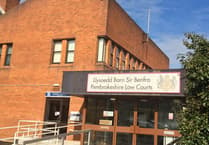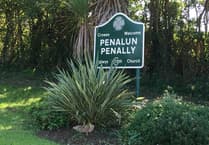Plans for new calf buildings one of the county’s largest dairy farms are expected to be approved despite claims it could lead to animal welfare issues and an increase in the size of the herd to 3,000 cattle.
At the September 3 meeting of Pembrokeshire County Council’s planning committee, an application by Hugh James of Langdon Mill Farms Ltd for a calf building, weaned calf building, and associated yard areas, at Langdon Mill Farm, near Jeffreyston, Kilgetty is recommended for conditional approval.
The application was previously heard at the July meeting, again recommended for approval, but was deferred pending a site visit.
Ahead of that application, a supporting statement, through agent Reading Agricultural Consultants, said: “The holding currently has a milking herd of approximately 2,000 cows, which are housed indoors for the majority of the year, with dry cows [cows that are not lactating, prior to calving] and heifers grazed outdoors when weather and soil conditions permit.
“There has been significant investment in buildings and infrastructure at the farm over the last decade in respect of cattle accommodation, slurry storage, milking facilities, Anaerobic Digestion (AD) plant and feed storage. The unit is efficient, achieving yields of more than 10,000 litres/cow/year, with cows being milked three times/day in the 60-point rotary parlour.”
Currently, calves are reared at Langdon Mill Farm for two months before being transported off-site to be reared at a number of third-party farms in the area before being return later; the proposed 61.2m long calf building is required to accommodate young-stock, following separation from the cows, to two-months, with the 164.8m weaned calf building to be used for calves from two months to seven months.
The application said the proposals would “clearly make the enterprise more financially robust by reducing reliance on third party farms”.
However, concerns were raised at the July committee meeting by objector Ian Dennis, a former vet of some four decades’ experience, who described Langdon as occupying 3,000 acres of land with 2,000 cattle currently that “are never allowed to graze,” the proposal, he said, would add another 1,000 cattle to the site.
“This is factory farming, an intensive livestock unit, no longer a farm.”
He told planners a “mendacious and incorrect” ammonia emission report submitted by the applicants was “designed to bamboozle,” saying, despite his experience and scientific background, he needed expert support to assess.
He said only average figures were reported, rather than peaks and troughs, adding the “fictitious anaerobic digestion plant” had yet to be built, with planning permission now lapsed.
However, officers told members the applicant’s agent had said works on the digestor had actually started.
On the issue of animal welfare, Mr Dennis said he had “very huge concerns” about the scale of the development, differing from a planning officer report saying the scheme would bring animal welfare benefits.
16 letters of objection to the proposal have been received, raising concerns including claims the size of the operation is already out of keeping with the area, a potential impact on highway safety, environmental concerns including smell and claimed river pollution, a report for planners says.
Following the site visit, an officer report is recommending conditional approval of the scheme says: “The proposed development would enable consolidation of the existing enterprise by enabling calf rearing to be undertaken on site, rather than transporting calves to be reared off site on a number of third-party farms.
“This would enable efficiencies in the operation of an existing dairy farm business that will have associated environmental and animal welfare benefits. The business is established and of a nature that can only operate in a countryside location.
“The application site is on land that is controlled by the applicant as part of the existing dairy farming business. It is considered that the principle of the proposed agricultural buildings is acceptable.”





Comments
This article has no comments yet. Be the first to leave a comment.